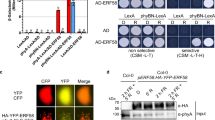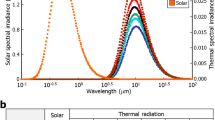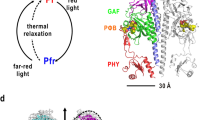Abstract
Light can both promote and inhibit germination, even of seeds of the same species1–3. Many seeds considered to be positively photoblastic are inhibited by prolonged irradiation with light of a wide variety of spectral qualities, including those, such as sunlight, that promote germination when given as a short exposure4. The promoting effect of light is mediated by the red/far-red reversible receptor pigment phytochrome operating in its Pfr form. The nature of photoinhibition is much less clear, although it is possible that continuous excitation of phytochrome is involved5. It has been suggested that light could control photomorphogenesis in seedlings not only through the establishment of a particular amount of phytochrome in its active Pfr form but also by determining the rate of ‘cycling’ between Pr and Pfr forms6,7. Such effects of prolonged irradiation are both wavelength and fluence rate dependent. We show here that the photocontrol of seed germination in Sinapis arvensis L. involves a promoting reaction dependent on the proportion of phytochrome in the Pfr form at photoquilibrium (φ) and an inhibiting reaction dependent on the rate of phytochrome interconversion or ‘cycling’ (H). Thus percentage germination can be quantitatively predicted from the spectral quality and the fluence rate of the seed's light environment.
This is a preview of subscription content, access via your institution
Access options
Subscribe to this journal
Receive 51 print issues and online access
$199.00 per year
only $3.90 per issue
Buy this article
- Purchase on Springer Link
- Instant access to full article PDF
Prices may be subject to local taxes which are calculated during checkout
Similar content being viewed by others
References
Negbi, M. & Koller, D. Pl. Physiol. 39, 247–253 (1964).
Rollin, P. Photochem. Photobiol. 5, 367–371 (1966).
Frankland, B. in Plants and the Daylight Spectrum (ed. Smith, H.) 187–204 (Academic, London, 1981).
Gorski, T. & Gorska, K. Planta 144, 121–124 (1979).
Hendricks, S. B., Toole, E. H., Toole, V. K. & Borthwick, H. A. Bot. Gaz. 121, 1–8 (1959).
Johnson, C. B. & Tasker, R. Pl. Cell Envir. 2, 259–265 (1979).
Hartmann, K. M. Photochem. Photobiol. 5, 349–366 (1966).
Gwynn, D. & Scheibe, J. Planta 106, 247–257 (1972).
Hendricks, S. B., Toole, V. K. & Borthwick, H. A. Pl. Physiol. 43, 2023–2028 (1968).
Schäfer, E. J. math. Biol. 2, 41–56 (1975).
Mancinelli, A. L. & Rabino, I. Bot. Rev. 44, 129–179 (1978).
Butler, W. L., Hendricks, S. B. & Siegelman, H. W. Photochem. Photobiol. 3, 521–528 (1964).
Hilton, J. Planta (in the press).
Author information
Authors and Affiliations
Rights and permissions
About this article
Cite this article
Bartley, M., Frankland, B. Analysis of the dual role of phytochrome in the photoinhibition of seed germination. Nature 300, 750–752 (1982). https://doi.org/10.1038/300750a0
Received:
Accepted:
Issue Date:
DOI: https://doi.org/10.1038/300750a0
This article is cited by
-
Photosystem stoichiometry adjustment is a photoreceptor-mediated process in Arabidopsis
Scientific Reports (2022)
-
Hormonal and environmental regulation of seed germination in salt cress (Thellungiella halophila)
Plant Growth Regulation (2015)
-
Photoregulation systems for light-oriented chloroplast movement
Journal of Plant Research (1996)
-
Some reflections on the relationship between endogenous hormones and light-mediated seed dormancy
Plant Growth Regulation (1992)
-
A preliminary study of micro‐spatial heterogeneity in the light spectral environment of seeds and seedlings in a grassland
Ecological Research (1989)
Comments
By submitting a comment you agree to abide by our Terms and Community Guidelines. If you find something abusive or that does not comply with our terms or guidelines please flag it as inappropriate.



